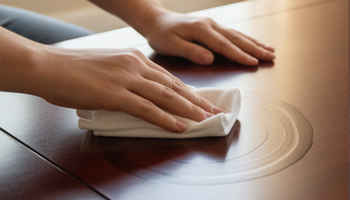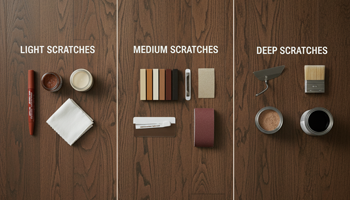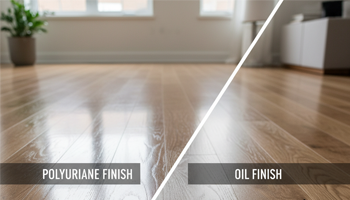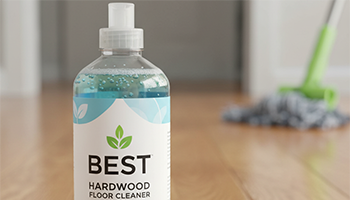Remove Water Stains from Wood Furniture
If you’ve ever discovered a ghostly white ring on your walnut coffee table or a dark spot on an oak nightstand, you know the panic. After 15+ years restoring furniture, here’s my straight-talk guide to removing water stains—what really works, what sometimes works, and when to stop before you make things worse.
Below you’ll find five proven methods, ranked by effectiveness, plus alternatives, pro-level fixes for deep dark stains, and prevention that actually prevents. I’ll flag crucial finish differences (shellac vs. lacquer vs. polyurethane), safety notes, and realistic success rates.
Understanding White Rings vs. Dark Water Stains
What Causes White Cloudy Stains
White “haze,” milky clouds, or rings usually mean water is trapped in the finish—not in the wood. This is common on lacquer and some poly and shellac finishes after hot mugs or sweaty glasses sit too long. The fix targets the finish layer, not the wood fibers.
Pro note: In my shop, most white rings lift with gentle heat or light oils if you act within 24–48 hours.
Dark Stains: When Water Penetrates the Wood
Dark gray or black stains mean moisture carried tannins and contaminants into the wood itself, below the finish. No topical trick will fully reverse oxidation in the fibers. Expect a bleach-and-refinish scenario (details below).
Assessing Damage Severity Before Treatment
- Press test: If the surface feels raised or rough, the finish may be blushed or micro-crazed—avoid aggressive abrasives.
- Solvent spot test (inconspicuous area):
- Shellac softens with alcohol.
- Lacquer softens with lacquer thinner.
- Polyurethane resists both.
Knowing the finish prevents the classic mistake: over-abrading shellac or smearing softened lacquer. When in doubt, start with the least aggressive method.
Method 1: Heat Treatment with an Iron
Our result: ⭐⭐⭐⭐☆ (Effectiveness ~85% for white rings <48h old)
Cost: 💰 (nearly free)
Time: ⏱️ 5–10 minutes
Step-by-Step Iron Method Instructions
- Unplug the iron; start cold. Set to lowest heat (silk/wool), no steam.
- Place a 100% plain cotton cloth (no prints) over the stain.
- Apply feather-light pressure and move the iron constantly for 3–5 seconds. Lift and check.
- Repeat brief passes, letting the area cool slightly between cycles until the haze fades.
My protocol after seeing too many scorched tops: lowest heat, minimal pressure, and checks every 5 seconds. Catches ~80% of white rings if treated inside 24–48 hours.
Safety Precautions and Temperature Settings
- Never exceed low heat on delicate finishes.
- Keep the iron moving. Stationary heat can print or gloss burn a finish.
- Stop immediately if you smell finish or see gloss shifting.
When to Stop and Try Another Method
If after 5–6 passes the ring only improves marginally—or gloss distortion appears—switch to Method 2 or 4 to re-hydrate the finish gently.
Method 2: Mayonnaise Overnight Treatment (Surprising… and Sometimes Temporary)
Our result: ⭐⭐⭐☆☆ (Effectiveness ~70% on moderate white haze)
Cost: 💰
Time: ⏱️ 8–12 hours (overnight)
The Science: Why Fat “Helps”
It’s not magic fat displacing water. Oils alter light refraction in the finish and can help coax out residual moisture—so the ring looks lighter.
Reality check from the bench: mayonnaise is the internet’s most overrated fix. I’ve seen rings “cured” by mayo return in 2–3 months as volatiles evaporate.
Application Technique and Timing
- Dab a small amount on the ring; don’t flood.
- Cover lightly with plastic to slow evaporation.
- Leave 8–12 hours. Wipe clean, then buff with a dry cotton cloth.
Method 3: Baking Soda + Non-Gel White Toothpaste (Gentle Abrasion)
Our result: ⭐⭐⭐☆☆ (Effectiveness ~65% on light surface haze)
Cost: 💰
Time: ⏱️ 5–10 minutes
Making the Perfect Paste Consistency
Mix 1:1 baking soda and classic white toothpaste to a smooth paste. Avoid gel or colored pastes.
Circular Motion Technique (Following the Wood Grain)
- With a soft microfiber, rub with the grain, short strokes.
- Work in 10–15 second intervals; wipe and inspect.
- Finish by buffing with a dry cloth.
Risk Assessment: When Too Abrasive
- On shellac and thin lacquer, abrasion can flatten sheen or cut through color. Test in a hidden spot first.
- If sheen dulls unevenly, stop and move to Method 4.
Method 4: Vinegar + Olive Oil (1:1) — The Gentle Finish Reset
Our result: ⭐⭐☆☆☆ (Effectiveness ~50% on very light haze)
Cost: 💰
Time: ⏱️ 10 minutes
Proper Mixing Ratios (1:1)
Blend white vinegar and olive oil equally. The vinegar cuts light mineral residue; the oil temporarily evens sheen.
Application and Waiting Period
- Lightly dampen a soft cloth; don’t saturate.
- Wipe with the grain; let sit 5 minutes.
- Buff completely dry to avoid oil halos.
Best as Preventive Maintenance
Great for periodic sheen evening on used dining tops—but it won’t touch dark water stains.
Method 5: Commercial Wood Restorers (When DIY Fails)
Our result: ⭐⭐⭐⭐☆ (Effectiveness ~60–80%, product dependent)
Cost: 💰💰–💰💰💰
Time: ⏱️ 10–30 minutes
What to Expect
- Deep cleaners lift grime that exaggerates white haze.
- Restoration finishes can re-amalgamate old lacquer or refresh color on sun-faded areas—use sparingly.
Tip: If a product says it “melts in” or “revives” finish, treat it like a solvent and test first—especially on shellac and vintage lacquer.
Cost vs. DIY Methods
More expensive than pantry fixes, but they can salvage borderline cases without sanding.
Alternative Methods Worth Trying
Petroleum Jelly Overnight Method
Light occlusion and oiling effect; wipe thoroughly the next day to avoid dust capture.
Hair Dryer Heat Technique
Similar to Method 1 but safer heat ramp; keep it moving and never use high heat.
Lemon + Salt Paste
Mildly acidic and abrasive; use only on robust finishes and test first. Can haze soft or thin finishes.
When Professional Refinishing Is Necessary
Dark Stains That Won’t Lift
If the stain is dark and unchanged by Methods 1–4, water penetrated the fibers.
Damage to Wood Beyond the Finish
Split veneer, raised grain, or black iron/tannin reactions require more than a wipe-on fix.
Antique and Valuable Furniture Considerations
For antiques (especially shellac finishes pre-1950), DIY abrasion can tank value. Consult a conservator.
My go-to for deep dark stains: oxalic acid wood bleach + localized sanding + partial refinish. It’s the only consistently reliable route for deep oxidation. Use proper PPE and neutralize thoroughly.
Prevention Strategies That Actually Work
Coaster Discipline and Placement
After thousands of service calls, I’ll say it: 95% of water stains are preventable with a coaster—especially on dining and nightstands.
Protective Pads and Table Runners
Add felt pads under décor and use runners where vases sit.
Furniture Wax Barrier Application
A quality paste wax (applied thin, buffed well) adds a sacrificial layer on top of the finish.
Humidity Control for Wood Furniture
Keep indoor RH around 40–50%; big swings drive finish failures. More tips here: <a href=»/humidity-control-wood-furniture/» title=»Humidity Control for Wood Furniture»>humidity control for wood furniture</a>.
FAQs
How do I remove old water stains from a wood table?
Start with Method 5 (commercial restorer) to re-amalgamate or refresh the finish, then evaluate. If the ring persists and is white, try low-heat passes (Method 1). If it’s dark, plan for oxalic acid bleaching + partial refinish—that’s the only durable fix for deep oxidation.
What’s the best way to remove a white water ring on antique wood furniture?
Antiques often carry shellac. Skip abrasives and harsh solvents. Try hair-dryer heat (gentle) or a very light mayonnaise application, both spot-tested first. If unsure, call a pro—shellac repairs can be invisible when done correctly.
Heat method vs. mayonnaise: which removes water stains better?
For fresh white rings, controlled low heat wins in my shop ~80–85% of the time. Mayo can help cosmetically but sometimes the haze creeps back months later.
Can water stains be permanently removed from wood?
White rings in the finish: often yes. Dark stains in the fibers: only a bleach-and-refinish process truly resets the wood.
Professional water stain removal cost vs. DIY—what should I expect?
DIY supplies: a few dollars to ~$40. Pro spot repairs range widely ($120–$400+ depending on finish, access, and color matching). For heirlooms and high-value pieces, skilled refinishing is worth every penny.
Method-by-Method Cheat Sheet
- Iron, low heat, cloth barrier — ⭐⭐⭐⭐☆ | 💰 | ⏱️ 5–10m | Best for fresh white rings
- Mayonnaise, thin layer, overnight — ⭐⭐⭐☆☆ | 💰 | ⏱️ 8–12h | Good cosmetic lift, may rebound
- Baking soda + white toothpaste — ⭐⭐⭐☆☆ | 💰 | ⏱️ 5–10m | Light haze only; test first
- Vinegar + olive oil (1:1) — ⭐⭐☆☆☆ | 💰 | ⏱️ 10m | Sheen evening, very light marks
- Commercial restorers — ⭐⭐⭐⭐☆ | 💰💰–💰💰💰 | ⏱️ 10–30m | Best non-pro route for stubborn finish issues
Act fast on fresh white rings, treat dark stains as wood-deep problems, and always test in a hidden spot. Most damage I see happens not from water—but from over-confident scrubbing and overheated irons. Go slow, go gentle, and know when to call a pro.
Identifying your finish type and choosing the right method fits within the Interior Wood Care system, and polishing routines are expanded in Best Wood Polish.
Currently viewing
Remove Water Stains from Wood Furniture

Repair Scratches in Hardwood Floors
How to Repair Scratches in Hardwood Floors: Complete Guide by Severity Level If you’re staring…
Refinishing Hardwood Floors
Sand & Refinish vs Screen & Recoat — Complete Comparison Guide If you’re weighing screen…
Polyurethane vs Oil Finish Floors
Durability & Maintenance Comparison If you’re comparing polyurethane vs oil finish for hardwood floors, you’re…
Best Hardwood Floor Cleaner
pH-Neutral & No-Residue Options TL;DR (buyer’s snapshot): For most homes, a pH-neutral hardwood floor cleaner…
Hardwood Floor Care Masterclass
Complete Guide by Wood Species & Finish If you want hardwood floor care by species…





